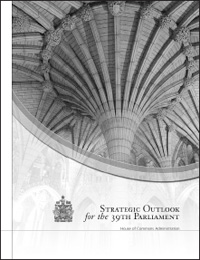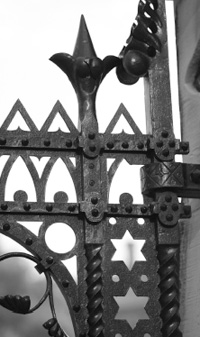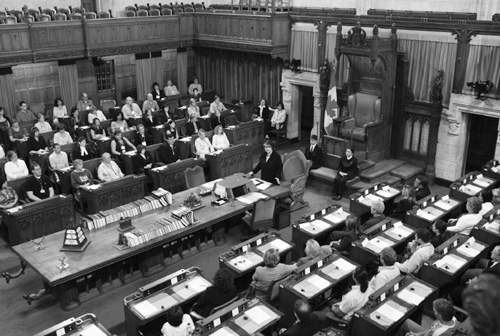Supporting Strategic Objectives
The House Administration has established four strategic
objectives that reflect its vision, values and mandate.
These objectives provide a focus for its efforts and
serve as a guide for activities during the 39th
Parliament and into the 40th Parliament.
The House Administration's Strategic Objectives
-
To respond to the evolving role of Members and the
institution;
-
To enhance ongoing services to Members and sustain the
institution;
-
To promote understanding and to support the advancement
of legislative institutions;
-
To apply the highest standards of public sector
governance in a parliamentary context.
This section of the Report to Canadians
describes the House Administration's accomplishments
during the 2008-2009 fiscal year in support of those
objectives. It also identifies the Administration's major
commitments for 2009-2010.
1. To Respond to the Evolving
Role of Members and the Institution
Supporting the Evolution of Parliamentary Practices and
Rules
The House Administration staff drafts amendments to the
Standing Orders of the House in accordance with
instructions from Members of Parliament and then updates
the procedural reference works made available to Members
of Parliament for Chamber and committee work. To that
end, the Compendium of House of Commons
Procedure is regularly updated to integrate changes
to practices and usages in the House, as procedures
continue to evolve. In addition, a duty-clerk is always
available to respond to procedural questions from Members
of Parliament, their staff or members of the public.
Following the election held in the fall of 2008, the
House Administration staff updated publications for
distribution to new and returning Members of Parliament.
Staff also responded to telephone calls seeking
information on procedural questions from Members of
Parliament, their staff and members of the public.
Ensuring a flexible technology infrastructure
The Parliamentary Precinct's information technology
network has been upgraded in Precinct buildings to ensure
a more reliable and manageable platform for the delivery
of information services. In 2008-2009, the House
Administration completed the implementation of a secure,
reliable and central information-storage environment for
Members. In addition, it renewed network services for
Members' constituency offices to provide fast and
flexible communications services.
In 2008-2009, the House Administration completed the
migration of the desktop environment to the new platform.
The project is part of an ongoing software and hardware
lifecycle program. These tools will enable the House of
Commons Administration to take full advantage of the
latest technology to respond to the ever-evolving needs
of its clients and the institution.
Improving Members' Access to Parliamentary Information
In 2008-2009 the House Administration provided Members
and the public with live and on-demand audio access to
all public committee events. ParlVU is an Internet portal
where Canadians and the media can see and hear Parliament
live and on demand, in both official languages. Building
on investments made in the House of Commons IT and
broadcasting infrastructure, rich media (i.e., media that
include advanced technologies such as streaming video)
can be repurposed, linked contextually to published text
and provided on demand. Whether it is parliamentary
schedules acting as virtual gateways or video clips that
tell a story, ParlVU provides an information service that
is relevant to Canadians.
The House Administration will introduce new services to
improve Members' access to parliamentary information.
Transcripts of parliamentary proceedings will be
available to add context within the ParlVU portal.
In the past fiscal year, the House Administration
introduced a new service to improve access to the voting
records of Members of Parliament. The Parliament of
Canada Web site can be used to access information by
vote, by bill, by political party or by individual
Member.
Just prior to the end of the 39th Parliament, the House
Administration made enhancements to the committees
section of the Web site. The improvements provide
Members, staff and the public with better access to
information regarding committee members and witnesses and
also offer improved subscription features that enable
users to follow the work of committees. Over the 40th
Parliament, it is expected that usage of these features
will increase. This will permit further refinements to
better serve parliamentarians and members of the public
alike.
A software tool for publishing both paper and electronic
documents and improving document workflow is being used
to improve the process supporting the publication of
documents for the International and Interparliamentary
Affairs Directorate, specifically to electronically track
a report from start to finish. Such a tool will
facilitate the entire publishing process from the draft
stage to the final step of tabling a report. It will also
be used to manage and publish articles for the
Compendium of House of Commons Procedure, making
it easier to update and maintain this important online
resource.
The administrations of the House of Commons, Senate and
Library of Parliament continued to be governed by a
common long-term vision and strategy for the enhancement
of parliamentary information services throughout
Parliament. In the fiscal year 2008-2009, the
Parliamentary Information Management (PIM) Committee,
representing all three institutions, developed a
governance model that clearly defines roles and
responsibilities, thereby enabling all participants to
work together effectively. In addition, it established a
tri-institutional group that began examining information
on legislation, one of the priorities established by PIM.
In the coming year, PIM will continue its efforts towards
the goal of producing more integrated and coherent
information services for clients. In particular, a
tri-institutional project team will work towards building
on recommendations that would result in increased
efficiencies and eliminate redundancies.
In the coming year, the House Administration will
undertake a review of its procedural publications,
specifically their content and the processes used to
produce them. In an effort to increase efficiency and to
offer the most accurate and timely procedural information
to Members, staff will focus on developing a
living-documents strategy.
2. To Enhance Ongoing Services
to Members and Sustain the Institution
Renovating the Parliamentary Buildings
The Long Term Vision and Plan for the Parliamentary
Precinct ensures that the Parliament Buildings and
grounds are preserved as heritage assets and national
symbols of Canada and meet the accommodation and
operational requirements of Parliament.
Working in collaboration with Public Works and Government
Services Canada, custodian of the buildings, the House
Administration staff, in its role as knowledgeable
client, continued to ensure that the planning, design and
installation of facilities, information technologies and
infrastructure meet the requirements of Members of
Parliament, their staff and parliamentary functions.
Planning continues on the major rehabilitation of the
West Block, with restoration work under way on the north
towers. To enable the rehabilitation of the building to
proceed, interim spaces are being created in the
Wellington, La Promenade and the former Canadian Museum
of Contemporary Photography buildings for committee
rooms, Members' offices and support functions displaced
from the West Block. Interim spaces have been created for
the administration functions that have been moved out of
the Wellington Building.
Improving Information Technology Services
Using voice-recognition technologies, the House
Administration now offers real-time closed captioning of
Question Period in both official languages. In addition,
closed captioning is now available for special events in
the Chamber, such as the budget speech and economic
statements.
No Room of Their Own
When the first Centre Block was designed in 1859 to
house the Parliament of the Province of Canada, the
architects, the Department of Public Works and even
parliamentarians themselves assumed Members would
require little more than the basic amenities of a desk,
a chair, a wardrobe and reading lounges. Only the
Speakers of the two Houses had their own offices.
Providing Members with accurate and high-quality
information and services is of paramount importance to
the House Administration. An upgrade of the Financial
Management System is well under way and scheduled for
deployment in late 2009. The upgrade will provide
additional functionality to both Members and the House
Administration. As part of the Finance Data Quality
Program launched in early 2009, an assessment of
financial-system controls showed a high level of
integrity and security.
A purchasing tool has been developed that is integrated
with the House Administration's financial system. It will
allow Members to purchase supplies online and have their
financial information updated simultaneously. The House
Administration will launch it as a pilot in early 2010
and, once the pilot results have been assessed, will
deploy it to all Members.
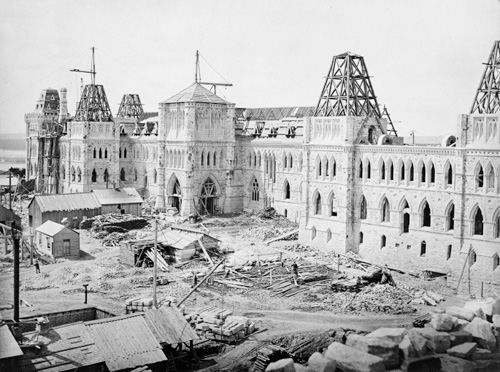
Parliament under construction, 1863
View of Main Front and Entrance Towers.
Photo: Samuel McLaughlin/Library & Archives
Canada/C-000773
Refining the Business Continuity and Resumption Plan for
the House of Commons
Ongoing planning ensures that the vital business of the
Chamber and committees can continue in the event of an
emergency situation requiring the House of Commons to
relocate. The House Administration has identified
critical service needs for all the areas of the House of
Commons.
Cutting-edge Information Technology Right from the
Start
The roots of information technology go much further
back than the appearance of computers in the House. The
Parliamentary Precinct boasts a number of firsts.
1867-Electric (battery-powered) call bells were
installed in the original Centre Block.
1877-Prime Minister Alexander Mackenzie made the first
commercial telephone call in Canada from room 310 West
Block to the Governor General's residence.
1927-The first-ever nationwide radio broadcast
originated on Parliament Hill.
1928-The first Canadian transatlantic telephone call
was made from the Centre Block to Cardiff, Wales.
1957-The opening of Parliament by the Queen was the
first time Her Majesty had used live television to
address citizens in any country of the Commonwealth.
1959-Simultaneous translation (interpretation) was
introduced to the floor of the House of Commons and the
press gallery.
1977-Regular TV and radio broadcasts from the Chamber
began.
1995-The Parliament of Canada Web site was launched to
provide worldwide access to parliamentary information.
2004-ParlVU Service was launched to provide worldwide
access to live video and audio proceedings.
Over the past year, staff defined, designed and tested a
Business Continuity Management (BCM)-Alternate Chamber
Plan for the moving of the Chamber to a different
location within the existing Parliamentary Precinct
boundaries. In addition, staff developed a BCM-Alternate
Centre Block design plan that, within 48 to 72 hours of a
declared event affecting the usability of Centre Block,
would enable the House of Commons to operate essential
services in an alternate location outside of the existing
Parliamentary Precinct boundaries.
Training and Orientation for Members and Their Staff
The Members' Orientation and Election Readiness Program
assists new Members of Parliament as they assume their
new functions by ensuring that Members have the
administrative, financial and procedural information and
services they need.
As an innovation this past fiscal year, the program
introduced the concept of Liaison Officers. Assigned to
new Members of Parliament, the Officers assist them in
navigating their way around the shoals of the first few
weeks in their new functions.
In addition, the administrative orientation component of
the program was redesigned to make it more targeted, with
improved documentation for Members. Staff also improved
services offered to Members of Parliament who are
transitioning to private life.
The House Administration also designed a tracking and
reporting system to identify milestones, document
processes and improve the quality and timeliness of the
information provided to management.
During the fiscal year 2008-2009, a risk assessment was
undertaken to clarify the processes and accountability
for the Members' Orientation and Election Readiness
Program. In 2009, staff will develop the results of that
assessment into a risk-mitigation plan.
The House Administration provided training sessions to
Members and their staff on the subject of Members'
allowances and services, and will be putting into place a
formal program whereby training sessions will be offered
on a regular basis.
Keeping the House of Commons Secure
The Master Security Plan (MSP) was completed during the
last fiscal year. It outlines the strategic security
direction for the Parliamentary Precinct for the next
several years. This comprehensive plan will see the
security services of both the Senate and the House of
Commons working with the Royal Canadian Mounted Police
(RCMP) toward maximizing their interoperability. It
proposes a series of strategic initiatives to evolve
security practices on Parliament Hill based on the
predominant themes of incident prevention and security
integration. Central to the plan is recognition that the
MSP will strengthen security and safety in the
Parliamentary Precinct while it promotes a welcoming
environment for all those who visit.
3. To Promote Understanding and
to Support the Advancement of Legislative Institutions
Updating Major Publications on Parliamentary Procedure
Work is under way on the final stages of the drafting,
review, translation and design of the second edition of
House of Commons Procedure and Practice.
Originally published in 2000, this book is a
comprehensive study of the House of Commons jurisprudence
that examines the forms, customs and procedures
established since Confederation. This new edition, to be
published in the fall of 2009, will take into account
changes to the Standing Orders and practices of the House
since the release of the first edition. It will also
include a number of revised and reorganized chapters,
several new graphics and a more complete bibliography
that lists reference works by chapter.
Detail of iron gates,
west entrance of
Parliament Hill
Photo: © House of Commons/
Holly Loranger
Over the last fiscal year, the House Administration also
published a number of other procedural works, including
the Selected Decisions of Speaker Gilbert Parent
and updates to the Guide for the Speaker and Chair
Occupants, the Glossary of Parliamentary
Procedure, the Private Members' Business
Practical Guide, the Committees Practical
Guide, the Petitions Practical Guide,
Amending Bills at Committee and Report Stages
and the Guide for Witnesses Appearing before House of
Commons Committees.
Providing Learning Opportunities for Parliamentarians and
Legislative Officials from jurisdictions in Canada and
Abroad
Staff offered numerous information and training sessions
on procedural topics to Members of Parliament, their
staff, employees of the research services of the various
caucuses and the House Administration. Of particular note
is the ongoing seminar series geared specifically to new
Members of Parliament and their staff on general topics
such as the parliamentary cycle.
Partnering with the Senate and the Library of Parliament,
the House of Commons hosts its Parliamentary Officers'
Study Program two to three times a year. This two-week
program affords an opportunity for senior parliamentary
staff from foreign legislatures and Canadian
jurisdictions to learn about procedural, administrative
and research practices and services provided to
parliamentarians.
To improve the ongoing training of procedural staff, the
House Administration will undertake a review of the
monthly sessions offered by Table Research Branch, which
provides information and advice on parliamentary
procedure. The goal will be to evaluate whether the
subject matter is suitable and appropriate, and whether
improvements are necessary.
Even security is a tradition
Barracks Hill was chosen for the Parliamentary Precinct
because it provided a natural boundary, with protective
topography along the east, north and west perimeters.
Designers equipped the south boundary of the new
precinct with a continuous fence featuring clearly
defined entry points for pedestrians and vehicles, and
all entrances had wrought iron gates that could be
closed in emergencies. The wide expanse of open lawn
was itself a security feature.
4. To Apply the Highest
Standards of Public Sector Governance in a Parliamentary
Context
Strengthening House of Commons Management Practices
In 2008-2009, staff in the Committees Directorate
undertook a detailed review of practices and processes
related to committee travel to ensure they were clear,
up-to-date, effective in mitigating risk and consistent
with other policies. Staff developed an action plan to
modify a number of processes, in concert with partners in
Finance Services and at the Department of Foreign Affairs
and International Trade.
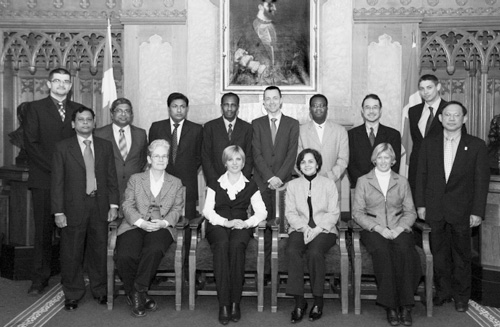
Parliamentary Officers' Study Program, February 2009
Back row from left to
right: Mr. Hrvoje Sadaric (Croatia -
Parliament); Mr. Chandradasa Kuruppu (Sri Lanka -
Parliament); Mr. Lacille De Silva (Sri Lanka -
Parliament); Mr. Suzaul Islam (Bangladesh -
Parliament); Mr. Richard Sono Agyapong (Ghana -
Parliament); Mr. Claus Dieter Koggel (Germany -
Federal Council); Mr. Simon J Uirab (Namibia -
National Assembly); Mr. Takeaki Yaoita (Japan - House
of Representatives); Mr. Nicolas Besly (United
Kingdom - House of Lords); and Mr. Montree Rupsuwan
(Thailand - Senate).
Front row, from left to
right: Ms. Anne Stokes (Ontario - Legislative
Assembly); Mrs. Nataliya Kozlovska (Ukraine -
Parliament); Ms. Susan Sourial (Ontario - Legislative
Assembly); and Ms. Fay Paterson (New Zealand - House
of Representatives).
Photo Credit: © House of Commons
Promoting sound stewardship and effective management of
public resources is a priority for the House
Administration. The following initiatives are directly
aligned with meeting the objectives of the Chief
Financial Officer (CFO) Model-a more strategic approach
to financial and resource management that promotes
responsible stewardship of resources, accountability and
transparency.
The House Administration is implementing an integrated
investment-planning framework to enhance the planning
process and ensure investments continue to be made
strategically. As part of a formal cycle of integrated
investment planning, now in its second year, priority
investments for achieving the House Administration's
strategic objectives in support of the work of Members
were confirmed. With respect to financial reporting, the
House Administration's financial statements continue to
be audited by an external firm. In 2008, the auditors
issued an unqualified report.
The House Administration also launched a procurement
manual and training program to ensure that goods and
services essential to supporting the work of Members are
acquired in a fair and cost-effective manner. In
addition, it updated the Procurement Policy and
began work on updating the Asset Management
Policy, the Prepaid Expenses and Deferred
Charges Policy and the Recovering Property and
Privileges of Departing Employees Policy.
The House Administration will begin implementation of an
automated procurement-management system in late 2009 that
will reinforce sound financial-management practices and
strong stewardship of public resources, key elements of
the CFO Model.
Managing Parliamentary Information
As the foundation is laid for the upcoming PRISM
migration, the House Administration has moved integral
parts of the Journals Plus application to a new platform
where the updated Procedural Review and Libraries modules
have been created. This provides the House Administration
with an improved and flexible system for recording and
sharing information on procedural events and also enables
the use of a standardized vocabulary when describing
these events. The advantage is that the same vocabulary
will be used when describing procedural events.
Sustaining a Motivated and Effective Workforce
The House of Commons, like many employers, will be facing
challenges in the coming years to recruit and retain
talent at a time when the Canadian workforce is
experiencing an increase in retirements and as the market
for skilled employees becomes more competitive. To
address these challenges, the House Administration has
developed a corporate human resources strategy that will
position the House to recruit strategically, retain new
employees by means of engagement and training strategies,
and provide support and development to leaders so that
they are well equipped to carry out their roles. These
strategic initiatives will ensure that the House of
Commons continues to have an engaged and ready workforce
to support the work of Members in committees, in the
Chamber and in the constituencies and that the
organization is regarded as a best employer in a
competitive marketplace.
The corporate human resources strategy includes
initiatives such as the development and alignment of
competency models in all service areas, which emphasize
competency evaluation and learning and development needs,
and the implementation of corporate succession planning
across the House Administration. The development of the
succession-planning program is under way and will be
aligned with a leadership-development program to ensure
that the organization's leaders have the knowledge and
skills they need to support and lead a complex and
multi-generational workforce.
An integral part of the human resources strategy will be
to provide performance statistics to measure the success
of initiatives in the areas of retention and employee
satisfaction. As part of its goal of managing talent, the
strategy includes the creation of an employer brand to
enhance the recruitment and retention of our key asset,
the staff of the House Administration.
PRISM is a House of
Commons technology program for managing procedural
information, publishing parliamentary publications and
supporting the planning of parliamentary events.
Representatives from the service areas of the House
Administration currently using PRISM will work to
establish business-led governance to support ongoing
investments. In the coming year, consultations will be
undertaken with users, and processes will be developed
to initiate, review and approve projects, as well as to
validate and deploy solutions. Within the updated PRISM
framework, these solutions will facilitate the
production of parliamentary publications and allow
information to be retrieved in a more timely and
efficient manner.
Journals Plus is a
database application that was originally developed to
help Procedural Services manage publications and
information (Standing Orders, Questions of Privilege,
Table Research Branch library files). Many of its
modules, along with their relevant information, have
been migrated to PRISM's Procedural Review and
Libraries module, a more stable and flexible platform.
Improving Environmental Management on the Hill
The House Administration participates in Partners for a
Green Hill, an active environmental committee that
includes representatives from the House Administration,
the Senate, the Library of Parliament and Public Works
and Government Services Canada. The committee is
finalizing a sustainable-development strategy designed to
ensure the continuous improvement of the environmental
programs in the Parliamentary Precinct.
In the development of renovation and construction plans
under the Long Term Vision and Plan for the Parliamentary
Precinct, the House Administration continued to integrate
best practices and standards of sustainable development
in the context of a heritage setting.
Audrey O'Brien, Clerk of the House of Commons, speaks
to employees during an Open House event
Photo: © House of Commons
< Previous | Next >




